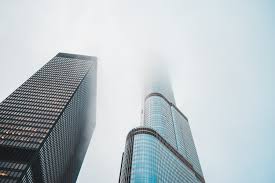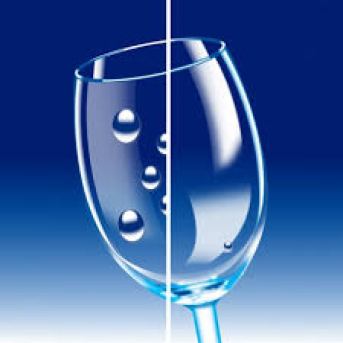We begin with two strange words, which in some ways are opposites—and in other ways are similar.
Welcome to the fascinating world of wetting.
First, let’s keep this simple. Let’s only think about water—as opposed to oily materials—that is deposited onto coatings, windows, mirrors, the leaves of plants, etc. The water (in the form of rain, steam, fog, etc.) may form droplets on the surface, or it may spread into a thin film. A hydrophobic substrate causes the water to form droplets; a hydrophilic coating, however, causes the water to spread into a thin film. But how do you keep these two terms straight, given that they sound so similar?
First, simple definitions:
Hydrophobic
Hydro = related to water (can’t be much simpler than that!)
Phobic = a form of the word phobia, meaning having a fear of or aversion to

Therefore, hydro+phobia is basically an aversion to water. So a hydrophobic coating repels water; that is, it causes water to bead up because the surface is repelling it. Just think “water repellency,” and you’ll always associate the hydrophobic property with water beading.
Hydrophilic
Hydro = same as above
Philic = a strong affinity for

Therefore, hydro+philic means attracted to water. A hydrophilic coating loves water. As the opposite of a hydrophobic coating, a hydrophilic coating will cause water to spread, not bead up.
Beading versus spreading
When considering the nature of beading and spreading properties, two things are important: 1.) the liquid (water, in this case), and 2.) the surface upon the which the liquid will rest. One property of any liquid is its surface tension. Rather than getting into the physics and chemistry of surface tension, let’s just declare that water has a very high surface tension, way higher than most other common liquids, such as solvents. A high surface tension means that the water molecules want to “stick together” and form beads on most surfaces. Compared to water, most other liquids, including solvents, have a much lower surface tension, and therefore the molecules are not as inclined to stick together and form beads on most surfaces.
The surface upon which the liquid rests has a surface property that sounds similar to one used for liquids. Instead of surface tension (to describe a property of a liquid), surface energy is used to describe a surface’s ability to pull a liquid toward it. Squeaky clean glass has a high surface energy; plastics—and this includes many paint films—have a very low surface energy.
 So, here’s the deal: If a high surface tension liquid (such as water) encounters a low surface energy solid (such as plastic or a freshly waxed car), the liquid will bead up. And if a low surface tension liquid, such as a solvent, encounters a high surface energy solid, like glass, the liquid will spread over the surface. And this is important why, you might ask? Fair question. Read on.
So, here’s the deal: If a high surface tension liquid (such as water) encounters a low surface energy solid (such as plastic or a freshly waxed car), the liquid will bead up. And if a low surface tension liquid, such as a solvent, encounters a high surface energy solid, like glass, the liquid will spread over the surface. And this is important why, you might ask? Fair question. Read on.
Let’s first consider the importance of water beading (i.e., hydrophobicity). Hydrophobic materials shed water extremely well, which can have the effect of keeping a surface clean. Hydrophobic effects can be very cool. Check out this video and you’ll see what I mean: https://www.youtube.com/watch?v=BvTkefJHfC0
Sadly, hydrophilic effect videos do not nearly provide the entertainment value, but here is a video that nicely demonstrates a key property—anti-fogging—of hydrophilic coatings. https://www.youtube.com/watch?v=ech8sjykUQQ
Okay, now you know the terms and have seen the effects, but how do they apply to coil coatings? You probably have an intuitive sense that hydrophobic coatings have some obvious applications, such as graffiti resistance and dirt shedding. If the paint or markers used by graffiti enthusiasts beads up or doesn’t stick very well to the coating, then the graffiti will be easier to remove. Water droplets that easily roll off a roofing or wall panel won’t dry out and leave dirt spots. We’ll come back to water spots shortly, but let’s first discuss hydrophilic materials.
When it comes to hydrophilicity, it’s best to think in terms of your dishwasher. Wait, what? You add “jet dry” to a dishwasher to eliminate water spots. In this case, the jet dry is mixed with the rinse water to lower the surface tension of the water. The just-cleaned glassware has a much higher surface energy than the rinse water with jet dry added. This combination has the effect of eliminating water beading, causing the water to “sheet off” your glassware. Here is a case where “sheeting” is better than “beading” to eliminate hard-water spots. And the same can be true of a coil coating that would allow water to sheet off the panel. Sounds simple enough, but creating a hydrophilic coil coating is substantially more difficult than formulating a hydrophobic one.
 There are a few conventional pathways to creating a water-beading (hydrophobic) surface, especially when you are starting with a coil coating, which is inherently hydrophobic. But consider the freshly waxed car, where you may see water beading on the sides of the car.
There are a few conventional pathways to creating a water-beading (hydrophobic) surface, especially when you are starting with a coil coating, which is inherently hydrophobic. But consider the freshly waxed car, where you may see water beading on the sides of the car.
And this same effect can also be seen on coil-coated wall panels. And this: There’s “hydrophobic,” but then there’s “superhydrophobic.” The explanation of the latter is not trivial, and the creation of a superhydrophobic surface requires a lot of effort. Suffice it to say that if the wax job on the car created a superhydrophobic surface, those droplets would definitely run off the car body. The same set of conditions exist with a coil-coated wall panel. Water from rain or dew forms droplets, but some of those droplets “stick” to the wall. If these beads of water contain dirt—and let’s face it, any water falling from the sky will contain some amount of dirt—as that bead dries out, the dirt is left behind, creating a dirt spot. Wouldn’t it be better if this water would sheet off a coil coating, just like the water does in a dishwasher? But, as mentioned earlier, it is exceptionally challenging to create a hydrophilic coil coating.
Poor hydrophilicity. It seems to struggle to get respect. So let’s take the excellent example of an important property, anti-fogging, where its value is worth the effort to create a hydrophilic surface. The hydrophilic demo video above shows this effect in action. It is interesting to learn how a hydrophilic (i.e., water-loving) surface works to clear up the fog. When water vapor forms on your mirror after a shower, or on your glasses when pouring steaming hot pasta and water into a colander, tiny, tiny droplets of water form, and the presence of these droplets scatters light (just like titanium dioxide and shaving cream), creating a foggy surface. With specially treated glass, however, these droplets don’t form.  Instead, because of the high-energy surface, the would-be droplets actually spread into a thin film. As a result, no scattering takes place. No scattering, no fog!
Instead, because of the high-energy surface, the would-be droplets actually spread into a thin film. As a result, no scattering takes place. No scattering, no fog!
A penny for your thoughts
I hope you have a better understanding now of our two water-related terms—hydrophobicity and hydrophilicity. These properties can be both beneficial and detrimental in coatings—it depends on the application. For example, should a coated-metal roof be snow shedding to avoid the occasional mini avalanche onto the ground, or do you want a roof where the snow—in a sense—sticks and eventually melts away? There are likely many other issues to consider when choosing a coating for its water-related properties, and you may have your own observations where altering the surface energy of the coating could overcome a problem. So, “water” you waiting for? Let me know at ncca.cocuzzi@gmail.com.
David Cocuzzi
NCCA Technical Director



